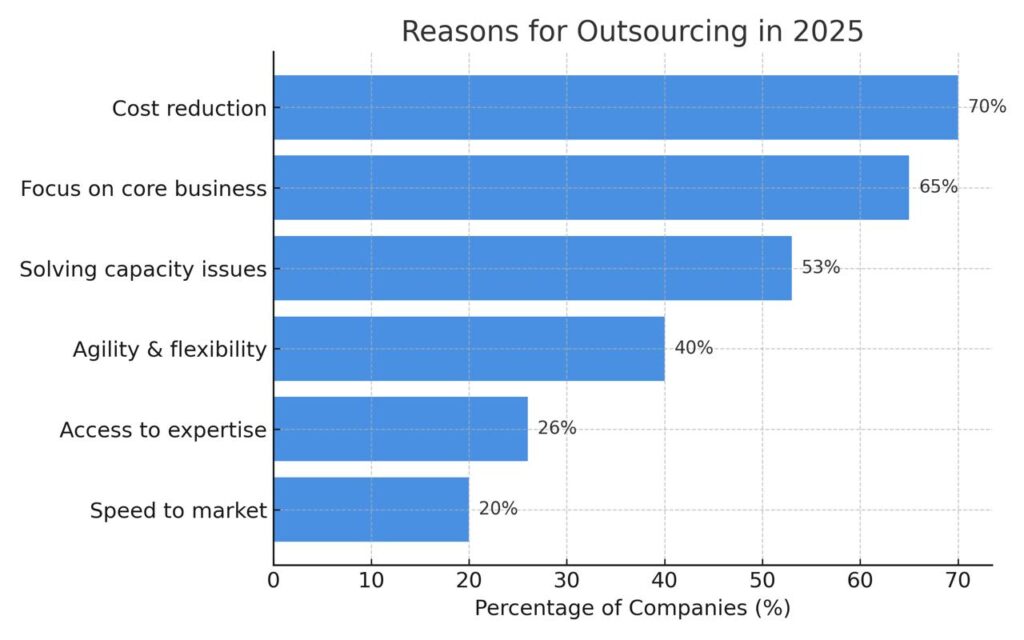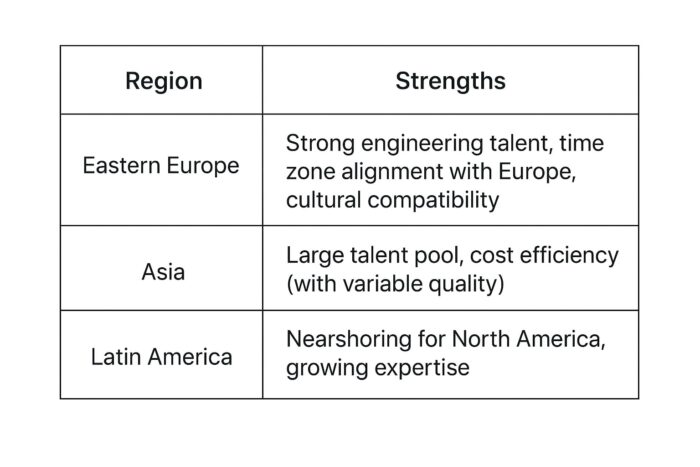In 2025, IT outsourcing has evolved into a strategic growth enabler—not just a cost-saving tactic. Modern businesses are no longer outsourcing to simply “get things done cheaper,” but to gain access to specialized talent, accelerate innovation, and remain agile in a volatile global landscape.
With rapid advancements in AI, automation, and cybersecurity, the scope of outsourcing has expanded beyond development to include data analytics, DevOps, cloud architecture, and product design. At the same time, new delivery models—like distributed agile teams, nearshoring, and outcome-based partnerships—are redefining how companies engage with external providers.
This article from Ficus Technologies explores the top outsourcing trends, benefits, and risks that every business leader should consider in 2025. Whether you’re scaling fast or optimizing operations, strategic outsourcing can give you a competitive edge—if done right.
- IT outsourcing in 2025 is no longer just cost-driven—it’s about speed, innovation, and flexibility.
- The most outsourced IT functions include development, cybersecurity, and cloud operations.
- Eastern Europe, Latin America, and Southeast Asia remain top outsourcing regions.
What Is IT Outsourcing — And Why It Still Matters
IT outsourcing involves partnering with external vendors to manage specific IT functions — from development and support to security and cloud operations.
Leading businesses like Google, Microsoft, Nike, and even government organizations continue to rely on outsourcing to:
- Reduce operational complexity
- Access scarce or specialized talent
- Accelerate product development
- Increase business flexibility
In 2025, the global IT outsourcing market is growing faster than ever, projected to reach over $405 billion by 2027.
Why Companies Outsource in 2025: The New Priorities
Based on recent data from Deloitte and market analysts, the primary reasons companies outsource include:

Cost optimization remains key — but in 2025, speed, agility, and innovation are just as important.
Most Commonly Outsourced IT Functions
Here are the top 10 IT functions businesses commonly outsource today:
- Application development
- Maintenance & support
- Datacenter operations
- Database administration
- Desktop & help desk support
- Disaster recovery
- Cybersecurity & penetration testing
- Network operations
- Web hosting
- Cloud infrastructure management
At Ficus Technologies, we specialize in building agile outsourcing models around these areas — from staff augmentation to full product teams.
Popular IT Outsourcing Models
Staff Augmentation – Extend your internal team with remote talent, fully integrated with your workflows.
Project-Based Outsourcing – Delegate an entire project to a specialized team with minimal overhead.
Dedicated Development Centers (DDC) – Set up a full-time offshore team managed by you, but supported locally.
Top Regions by Value

Cost Ranges (2025 Averages)
- Eastern Europe: $30–60/hr
- Latin America: $25–50/hr
- India & Southeast Asia: $20–40/hr
- Western Europe/US: $80–150/hr
Trends Driving IT Outsourcing in 2025
- AI & Automation at Scale
Companies are integrating AI-powered tools, RPA, and chatbots into business operations — and outsourcing their development.
Cloud Migration & Infrastructure Modernization – with cloud spending projected to exceed $623 billion in 2025, cloud architecture and DevOps services remain in high demand. - Remote Work & Cybersecurity
With 81% of companies adopting hybrid models, secure remote infrastructure is now a top outsourcing focus.
5G and IoT Expansion – outsourcing partners are increasingly needed to support edge computing, smart manufacturing, and connected logistics powered by 5G. - Ecommerce & Digital Product Development
The rise of digital-native business models is driving demand for outsourced development of marketplaces, apps, and integrations.
Key Risks to Address Proactively
- Loss of visibility or control over delivery
- Data protection concerns and legal compliance
- Over-reliance on one vendor
- Language and cultural gaps
- Misalignment of time zones
At Ficus Technologies, we mitigate these risks with transparent collaboration, secure data practices, and dedicated delivery teams.
The global demand for tech talent keeps rising. In the U.S. alone, over 255,000 new IT jobs will be created by 2026.
With local markets unable to meet demand, outsourcing gives companies instant access to developers, designers, DevOps specialists, and more.
Outsourcing also helps internal teams learn and grow through cross-team collaboration — a bonus few talk about.
Benefits of Smart IT Outsourcing
- Cost efficiency
- Faster execution
- On-demand expertise
- Security at scale
- 24/7 operations across time zones
- Capacity to scale with business needs
Discover How Outsourcing Can Transform Your Project!
Contact usConclusion
IT outsourcing in 2025 is no longer a tactical decision—it’s a strategic lever for innovation, resilience, and global scalability. As businesses navigate complex digital landscapes, outsourcing provides a path to faster delivery, access to specialized expertise, and flexible resource models that adapt to real-time demands.
However, to unlock these benefits, companies must choose outsourcing partners that align with their culture, goals, and technology standards. Success depends not just on contracts and pricing, but on shared vision, transparent communication, and measurable outcomes.
At Ficus Technologies, we help companies transform outsourcing into strategic advantage. From dedicated development teams to end-to-end project delivery, we offer flexible engagement models backed by deep technical expertise and proactive partnership.
Why Ficus Technologies?
Selecting the right outsourcing partner is not just about reducing costs — it’s about enabling long-term strategic success. At Ficus Technologies, we treat outsourcing as a partnership for growth, helping our clients scale operations, accelerate innovation, and remain competitive in today’s fast-changing environment.
Our strength lies in two pillars:
- Deep expertise across critical domains: from software development and DevOps to cybersecurity, cloud architecture, and data analytics. We cover the full spectrum of IT functions most commonly outsourced.
- Flexible engagement models: staff augmentation, project-based outsourcing, and dedicated development centers (DDC) — all tailored to your specific business needs.
At Ficus Technologies, we don’t just provide external resources. We build dedicated, integrated teams that align with your culture, processes, and goals — acting as a seamless extension of your organization.
Staff augmentation remains the most flexible, while dedicated teams are ideal for scaling sustainably.
Look for proven industry experience, clear communication practices, and the ability to integrate with your internal processes.
Yes, if the partner uses modern security protocols, data encryption, and adheres to frameworks like GDPR or HIPAA.
Eastern Europe offers the best balance of cost, quality, and timezone compatibility—especially for EU-based and U.S. clients.
With the right provider, onboarding can begin in 1–2 weeks, depending on the complexity of your requirements.








